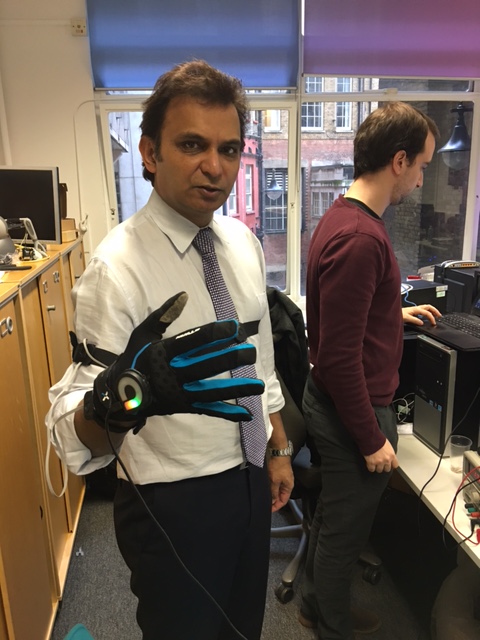Laparoscopy and robotics – an overhyped rivalry?
Highlights from the Laparoscopy & Robotics subspecialty meeting at the 50th annual conference of the Urological Society of India (Mumbai, India)
It was like Australia and England playing a friendly cricket match in the middle of the Ashes tour…or perhaps Liverpool and Manchester United fans celebrating together in the spirit of bonhomie…
In an ably conducted sub specialty meeting during the golden jubilee annual conference of the Urological Society of India, Dr. Mallikarjuna Chiruvella from Hyderabad, the hub of the Indian software revolution, brought together traditional rivals, Laparoscopy and Robotics – not for comparisons and conflicts – but to find common ground in terms of improving outcomes and handling complications.
Undoubtedly, there is a lot in common when it comes to these two modalities. Indeed one is the progeny of the other. The anatomy, approach, indications, complications, and indeed, the ways of dealing with them have more similarities than differences. Experts from both sides of the fence highlighted these similarities and delved into the finer technical points of these modalities across the wide spectrum of urological ailments – urolithiasis, reconstructive urology and urologic oncology. An important component was the special emphasis on laparoscopic training and suturing techniques.
Our very own Editor In Chief, Prof. Prokar Dasgupta, was the show stopper with an exciting talk on the future of robotic surgery in which he explored advancements related to imaging integration, in vivo microscopy, automation, virtual reality and haptic feedback in the next gen robotic systems of the future.
Video clip of Prof Dasgupta’s slides (no audio).
Sub specialty convener, Dr Mallikarjuna and co conveners, Dr Arvind Ganpule from Nadiad, Gujarat and Dr. Gagan Gautam from New Delhi managed to raise some goosebumps in the 500+ attendees by presenting 3 ‘nightmares’ video sessions which took a keen look at intraoperative disasters and ways and means of preventing and managing them.
While the debates on laparoscopy versus robotics continue, the content and conduct of the meeting ensured that everyone could take away something practical and implementable from this session. Here’s to the new found common ground!
Gagan Gautam Head – Urologic Oncology & Robotic Surgery, Max Institute of Cancer Care, New Delhi, India. Twitter: @DrGaganGautam
Dr. Mallikarjuna Chiruvella Managing director, Asian Institute of Nephrology and Urology, Erramanzil colony, Hyderabad, India




Happy 50th Anniversary to #USICON2017.
It was so much fun being part of this program.
As I watched the OMG moments with horror, I was convinced that “prevention is better than cure”.
For example it was great to see how a profuse and rapid inferior epigastric bleed can be stopped with an endoclose stitch. However that injury could have been prevented by dimming the OR lights, shining the light from the camera onto the anterior abdominal wall and then placing the ports to avoid all major vessels.
While the debate continues, we should remember the bottom line is “Laparoscopy stands on the shoulders of open surgery and robotic surgery stands on the able shoulders of laproscopy!!”
I was there to witness this amazing session on laparoscopy and robotics , where everyone were trying to showcase whats the best you could do with either laparoscopy or robotics rather than discuss which modality is superior . This helped all of us to decide which is best suited for us rather than go home with a big question in our heads . . . Hats off to the masters on the dias Dr. Mallikarjuna , Dr. Prokar Das , Dr.Gagan gautam . . . . and all other urologists who made it top class
The session on Laparoscopy conducted by Dr Mallikarjuna.C at the recently concluded USICON Golden jubilee meet at Mumbai had lots of take home messages. It was a really an intriguing session for the young urologists, who want to excell and learn Laparoscopy. The session on nightmares presented by Dr Gagan Gautam, Dr Arvind and Dr Mallikarjuna was excellent. We need sessions and debates in where complications and how they were managed should be discussed on most of the plenaries.
The key steps to stop bleeding from the internal iliac artery during a robotic pelvic lymph node dissection? Pressure, suction and a rescue stitch.
But as Gagan Gautam acknowledged, it was his experienced patient side assistant who quickly made the rescue stitch available, allowing him to suture precisely.
Morale of the story – team training/human factors are vital in robotic surgery
Dear Dr Prokar I do agree with your comment on Endoclose stitch but it doesn’t highlight deep inferior epigastric vessels. It only highlights superficial vessels. A double stitch or open conversion helps.
The endoclose is similar to a Carter-Thomason device and can stitch through and through the full thickness of the abdominal wall.
May I request Lap and robotic surgeons to post their Top Tips on dealing with and avoiding complications HERE to create perhaps a nice repository?
Particularly in high risk pts with extracapsular disease,during posterior dissection at RARP, following opening the Denonvillier’s fascia, I always shift to 30 degrees up lens with Da Vinci xi that shows the planes between rectum & prostate base very nicely that leads to a very safe dissection.
During performing extended pelvic LN dissection in the area of obturator nerve at RARP/RARC, I shift to close up & x4 magnification with Da Vinci xi that nicely shows small vessels and all details that I think is very useful to prevent unnecessary bleeding.Sometimes,these small vessels at this area might bleed a lot that might prolong OR time and increase EBL.
I always secure at least renal artery with a vascular tape before prooceding to zero ischemia off clamp partial nephrectomy. This would lead to easy identification of the renal artery to apply a bulldog clamp in case of unexpected bleeding as a safety precaution.
During RARC with intracorporeal diversion,my tips to prevent/overcome tight urethro-ileal anastomosis include:
1.adjusting trendelenburg to 5 degrees
2.make a perineal push (assistant surgeon)
3.making transverse peritoneal incisions on the ileal meso
4.retracting the urethral catheter with its baloon inflated
This expert list of comments are of great value. Differing lap and robotic techniques I am now aware of during my fellowship conversion are:
– Direction of traction generally perpendicular in lap, but able to pull in the line of ports to expand planes in robotics
– Using the opening wristed action of robotic instruments to display planes or key structures vital, but need to be aware of tension transfer without haptics
– suturing from inferior to superior with both hands preferable in robotics, lap suturing limited in planes available
Just tested the new version of the Glove from Neurodigital (see video above) in our Robotics and Telecoms lab at King’s College London.

I was able to remotely control a 3D printed robotic gripper which could palpate otherwise impalpable tumours in a kidney model over a high speed pre5G connection.
We are launching this at the Mobile World Congress in Barcelona #MWC17 (mobileworldcongress.com)